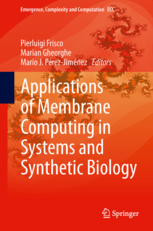
|
PD Dr.-Ing. habil.
Thomas Hinze
Senior University Lecturer and Independent Research Fellow
|
|
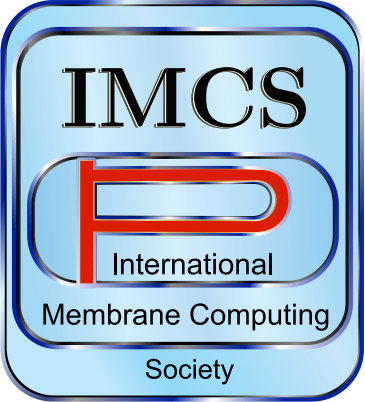  |
 |
![[Deutsch]](de.png) |
| Research Interests
| Teaching
| Publications
| Presentations
| Commitment for Students
| CV
|
Fields of Interest and Research
- Biologically Inspired Computing (in vitro, in vivo, in silico)
- Molecular Computing (DNA-, RNA-, Protein-Computing, Chemical Computing, Dynamical Structures)
- Membrane-, Cell-Based, Neural, Amorphous, Evolutionary Computing, Artificial Life, Organic Computing
- Systems, Synthetic, and Algebraic Biology for Exploration of Biological Information Processing
Book Gallery
Springer Textbook on Simulation Tools for Processes of Biological Information Processing
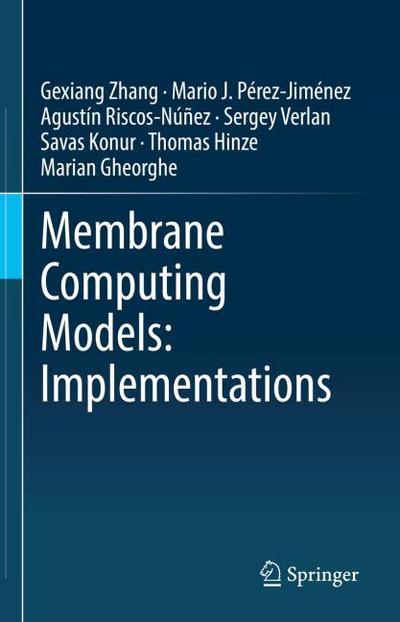
Product Flyer |
Gexiang Zhang, Mario J. Perez-Jimenez, Agustin Riscos-Nunez, Sergey Verlan, Savas Konur, Thomas Hinze, Marian Gheorghe.
Membrane Computing Models: Implementations.
Springer-Verlag, 301 p., 2021,
ISBN 978-981-16-1565-8
The theoretical basis of membrane computing was established in the early 2000s with fundamental research into the computational power, complexity aspects and relationships with other (un)conventional computing paradigms. Although this core theoretical research has continued to grow rapidly and vigorously, another area of investigation has since been added, focusing on the applications of this model in many areas, most prominently in systems and synthetic biology, engineering optimization, power system fault diagnosis and mobile robot controller design. The further development of these applications and their broad adoption by other researchers, as well as the expansion of the membrane computing modelling paradigm to other applications, call for a set of robust, efficient, reliable and easy-to-use tools supporting the most significant membrane computing models. This work provides comprehensive descriptions of such tools, making it a valuable resource for anyone interested in membrane computing models.
|
Post-Conference Proceedings of the Nineteenth International Conference on Membrane Computing (CMC19)
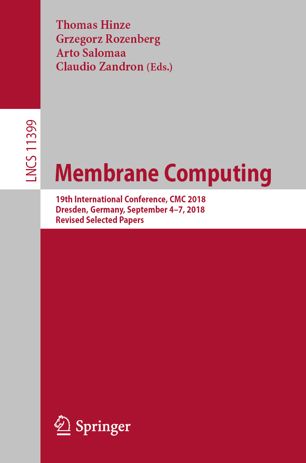
Front Matter |
Thomas Hinze, Grzegorz Rozenberg, Arto Salomaa, Claudio Zandron (Editors).
Membrane Computing. Nineteenth International Conference, CMC 2018,
Dresden, Germany, September 4-7, 2018. Revised Selected Papers.
Series Lecture Notes in Computer Science, Vol. 11399
Springer-Verlag Berlin, Heidelberg, 288 p., 2019,
ISBN 978-3-030-12797-8
This book constitutes revised selected papers from the 19th International Conference on Membrane Computing (CMC19), which was held in Dresden, Germany, in September 2018. The 15 papers presented in this volume were carefully reviewed and selected from 20 submissions. The contributions aim to abstract computing ideas and models from the structure and the functioning of living cells, as well as from the way the cells are organized in tissues or higher order structures.
|
German-Speaking eBook for Free
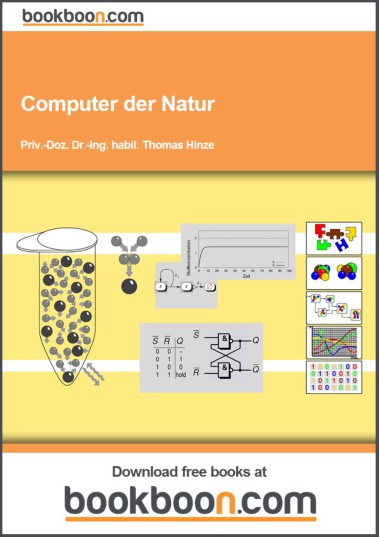
Vorwort
Inhaltsverzeichnis |
Thomas Hinze.
Computer der Natur.
Ausgewählte molekulare Prinzipien der biologisch inspirierten Informationsverarbeitung.
Verlag bookboon.com, London, 118 p., 2013, in German
ISBN 978-87-403-0378-0
Biologische Mechanismen der Informationsverarbeitung gelten als zuverlässig, anpassungsfähig und effizient. Sie beruhen größtenteils auf molekularen Interaktionen. Moleküle dienen hierbei als Speichermedium und übernehmen die Rolle des Datenträgers, auf dem feinabgestimmte biochemische Reaktionen operieren. Daraus resultiert eine alternative Hardware im Nanometermaßstab, deren ingenieurtechnische Erschließung über die Bionik hinaus mannigfaltige Anwendungen verspricht, die die Informatik in vielerlei Hinsicht bereichern und weiterentwickeln können. Aufbauend auf Grundlagen chemischer Reaktionen und kinetischen Gesetzmäßigkeiten ihres zeitlichen Ablaufs werden zahlreiche Beispiele chemischer Analog- und Digitalcomputer vorgestellt und leicht nachvollziehbar erklärt. Die Palette reicht dabei von biologischen Uhren als chemische Regelkreise über molekulare Arithmetik bis hin zu Zellsignalnetzwerken, die als endliche Automaten oder programmierbare Registermaschinen arbeiten. Zahlreiche Abbildungen veranschaulichen die einzelnen Molekularcomputermodelle. Das Lehrbuch gibt einen breiten Überblick über das Wissensgebiet und wendet sich gleichermaßen an Einsteiger wie Fortgeschrittene.
|
Post-Conference Proceedings of the Eleventh International Conference on Membrane Computing (CMC11)
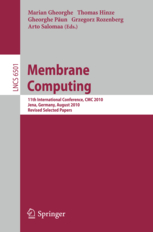
Preface
Contents |
Marian Gheorghe, Thomas Hinze, Gheorghe Paun, Grzegorz Rozenberg, Arto Salomaa (Editors).
Membrane Computing. Eleventh International Conference, CMC 2010, Jena, Germany, August 24-27, 2010. Revised Selected Papers.
Series Lecture Notes in Computer Science, Vol. 6501
Springer-Verlag Berlin, Heidelberg, 393 p., 2010,
ISBN 978-3-642-18122-1
This book constitutes the thoroughly refereed post-conference proceedings of the 11th International Conference on Membrane Computing, CMC11, held in Jena, Germany, in August 2010 - continuing the fruitful tradition of 10 previous editions of the International Workshop on Membrane Computing (WMC). The 23 revised full papers presented together with 4 invited papers and the abstracts of 2 keynote lectures were carefully reviewed and selected from numerous submissions. The papers address in this volume cover all the main directions of research in membrane computing, ranging from theoretical topics in the mathematics and computer science to application issues. A special attention was paid to the interaction of membrane computing with biology and computer science, focusing both on the biological roots of membrane computing, on applications of membrane computing in biology and medicine, and on possible electronically based and bioinspired implementations.
|
The First German-Speaking Textbook of DNA Computing
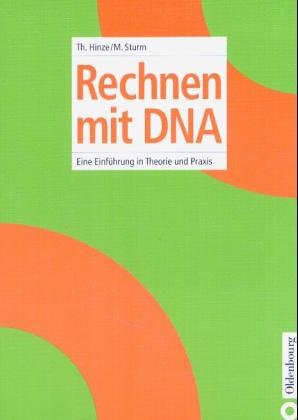
Preface
Contents |
Th. Hinze, M. Sturm.
Rechnen mit DNA - Eine Einführung in Theorie und Praxis.
(Computing with DNA - An Introduction into Theory and Practice.)
Oldenbourg Wissenschaftsverlag München, 316 p., 2004,
ISBN 3-486-27530-5
The German-speaking book provides a comprehensive and systematic
introduction into the interdisciplinary field of DNA Computing
including its mathematical and molecular biological background. DNA
Computing is focused on biological computers whose storage medium and
data carrier is formed by organic molecules. Appropriate molecular
biological and biochemical processes perform computational operations
inside wet test tubes. DNA-based algorithms use a massive data
parallelism. This leads to a performance of DNA computers that can
challenge the electronic state of the art technology. There are many
interesting practical applications in many branches. Their
commercialization has already begun. The transfer of basic knowledge
about DNA computing is completed by the detailled introduction of
models, methods, and techniques that prepare practical in-vitro
implementations in the laboratory. Particularly process simulations on
a submolecular level based on thermodynamics and reaction chemistry
are considered.
|
Some Scientific Links

CMC19 Dresden 2018
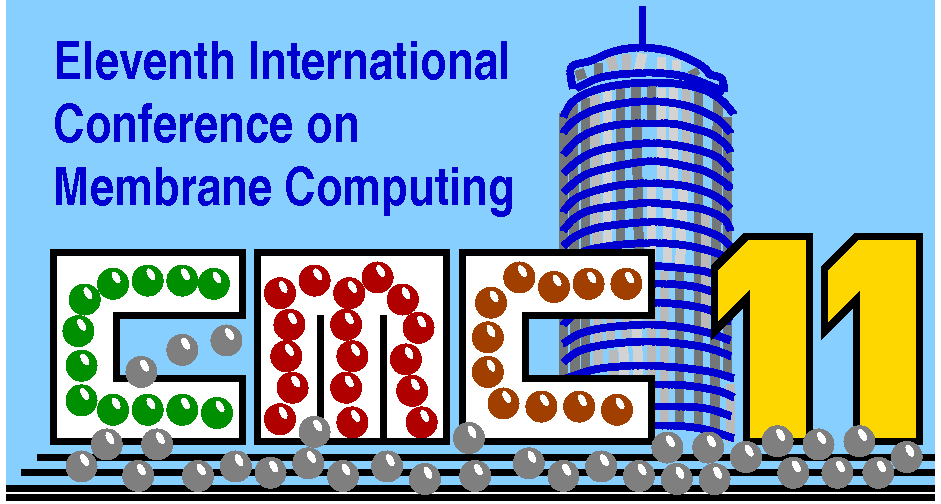
CMC11 Jena 2010
|
- International Membrane Computing Society (IMCS)
- P Systems Webpage
- International Conference on Membrane Computing (CMC/WMC)
1, 2, 3, 4, 5, 6, 7, 8, 9, 10, 11, 12, 13, 14, 15, 16, 17, 18, 19, 20, 21, 22, 23, 24
- International Conference on DNA Based Computers (DNA)
1, 2, 3, 4, 5, 6, 7, 8, 9, 10, 11, 12, 13, 14, 15, 16, 17, 18, 19, 20, 21, 22, 23, 24, 25, 26, 27, 28, 29
- International Conference on Bio-Inspired Systems and Signal Processing (BIOSIGNALS)
2008, 2009, 2010, 2011, 2012, 2013, 2014, 2015, 2016, 2017, 2018, 2019, 2020, 2021, 2022, 2023
- International Conference on and Society for Artificial Life (ALIFE)
2021, 2023
|
Commitment for Students











